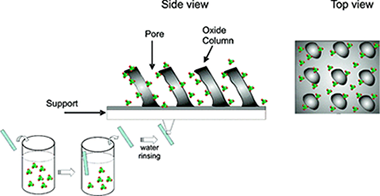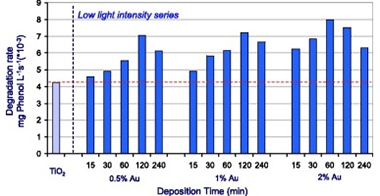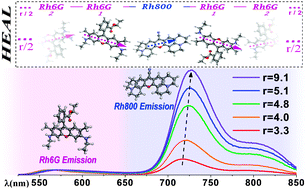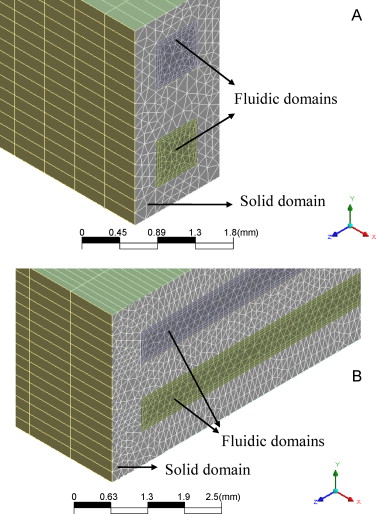Artículos SCI
2011
2011
Nanotecnología en Superficies y Plasma
Novel guests for porous columnar thin films: The switchable perchlorinated trityl radical derivatives
Oliveros, M; Gonzalez-Garcia, L; Mugnaini, V; Yubero, F; Roques, N; Veciana, J; Gonzalez-Elipe, AR; Rovira, CLangmuir, 27 (2011) 5098-5106
Show abstract ▽

TiO2 and SiO2 porous thin films consisting of tilted nanocolumns prepared by glancing angle evaporation (GLAD) have been infiltrated with guest derivatives belonging to the family of perchlorinated trityl radicals, novel guest molecules presenting an open-shell electronic configuration associated with paramagnetism, fluorescence, and electroactivity. The main driving forces for infiltration from aqueous solutions of the carboxylate-substituted radical derivatives are the electrostatic interactions between their negative charge and the net positive charges induced on the film pores. Positive charges on the internal surface of the films were induced by either adjusting the radical solution pH at values lower than the point of zero charge (PZC) of the oxide or passivating the nanocolumns oxide surface with a positively charged aminosilane. The infiltrated composite thin films are robust and easy to handle thanks to the physical protection exerted by the film columns. They also keep the multifunctionality of the used guests, as confirmed by electron paramagnetic resonance (EPR), UV-vis spectroscopy, and fluorescence spectroscopy. To prove the electroactivity of the infiltrated porous films, a porous TiO2 host layer was supported onto conductive indium tin oxide (ITO). By application of an appropriate redox potential, the guest radical molecules have been reversibly switched from their open-shell electronic configuration to their diamagnetic state and hence changed their optical properties. On the basis of these results, it is herein proposed that the appropriate surface functionalization of the pore internal surface of GLAD thin films can be used to prepare novel radical-oxide composite thin films usable for the development of robust switchable electrically driven photonic and magnetic devices.
Abril, 2011 | DOI: 10.1021/la200470f
Materiales y Procesos Catalíticos de Interés Ambiental y Energético - Fotocatálisis Heterogénea: Aplicaciones
Photodeposition of gold on titanium dioxide for photocatalytic phenol oxidation
Hidalgo, MC; Murcia, JJ; Navio, JA; Colon, GApplied Catalysis A-General, 397 (2011) 112-120
Show abstract ▽

The influence of experimental conditions during the photodeposition in the preparation of supported Au on TiO2 has been studied. Besides preparation pH, light intensity and deposition time showed to have a high influence on the final properties of gold deposits. Photodeposition using illumination with a high light intensity UV-vis lamp (140 W/m2 UVA range) resulted to be an ineffective method for obtaining nanoparticles of gold on the titania, producing very large and poorly distributed gold deposits. Thus obtained materials did not show any important improvement of their photocatalytic activity tested for phenol oxidation. By contrast, photodeposition using a low light intensity of illumination (0.15 W/m 2 UVA range), produced materials with notably improved photocatalytic activity. The illumination with such a low light intensity allowed the control of the amount, aggregation and oxidation state of gold by changing deposition time, enabling a feasible method of tailoring Au-TiO2 with the appropriate properties for a high photocatalytic activity. Best photocatalytic behaviour for phenol photodegradation was obtained for Au-TiO2 samples prepared by photodeposition at low light intensity with 120 min photodeposition time for catalysts with a 0.5% and 1% nominal content of gold and with 60 min photodeposition time for catalyst with a 2% nominal content of gold.
Abril, 2011 | DOI: 10.1016/j.apcata.2011.02.030
Materiales Ópticos Multifuncionales
Analysis of artificial opals by scanning near field optical microscopy
Barrio, J; Lozano, G; Lamela, J; Lifante, G; Dorado, LA; Depine, RA; Jaque, F; Miguez, HJ. Appl. Phys., 109 (2011) 083514(5 pages)
Show abstract ▽

Herein we present a detailed analysis of the optical response of artificial opal films realized employing a near-field scanning optical microscope in collection and transmission modes. Near-field patterns measured at the rear surface when a plane wave impinges on the front face are presented with the finding that optical intensity maps present a clear correlation with the periodic arrangement of the outer surface. Calculations based on the vector Korringa-Kohn-Rostoker method reproduce the different profiles experimentally observed as well as the response to the polarization of the incident field. These observations constitute the first experimental confirmation of the collective lattice resonances that give rise to the optical response of these three dimensional periodic structures in the high-energy range.
Abril, 2011 | DOI: 10.1063/1.3573777
Nanotecnología en Superficies y Plasma
Rhodamine 6G and 800 J-heteroaggregates with enhanced acceptor luminescence (HEAL) adsorbed in transparent SiO2 GLAD thin films
Sanchez-Valencia, JR; Aparicio, FJ; Espinos, JP; Gonzalez-Elipe, AR; Barranco, APhysical Chemistry Chemical Physics, 13 (2011) 7071-7082
Show abstract ▽

An enhanced fluorescent emission in the near infrared is observed when the Rhodamine 800 (Rh800) and 6G (Rh6G) dyes are coadsorbed in porous SiO 2 optical thin films prepared by glancing angle deposition (GLAD). This unusual behavior is not observed in solution and it has been ascribed to the formation of a new type of J-heteroaggregates with enhanced acceptor luminescence (HEAL). This article describes in detail and explains the main features of this new phenomenology previously referred in a short communication [J. R. Sánchez-Valencia, J. Toudert, L. González-García, A. R. González-Elipe and A. Barranco, Chem. Commun., 2010, 46, 4372-4374]. It is found that the efficiency and characteristics of the energy transfer process are dependent on the Rh6G/Rh800 concentration ratio which can be easily controlled by varying the pH of the solutions used for the infiltration of the molecules or by thermal treatments. A simple model has been proposed to account for the observed enhanced acceptor luminescence in which the heteroaggregates order themselves according to a "head to tail" configuration due to the geometrical constrains imposed by the SiO2 porous matrix thin film. The thermal stability of the dye molecules within the films and basic optical (absorption and fluorescence) principles of the HEAL process are also described.
Abril, 2011 | DOI: 10.1039/c0cp02421j
Química de Superficies y Catálisis
Selective CO removal over Au/CeFe and CeCu catalysts in microreactors studied through kinetic analysis and CFD simulations
Arzamendi, G; Uriz, I; Dieguez, PM; Laguna, OH; Hernandez, WV; Alvarez, A; Centeno, MA; Odriozola, JA; Montes, M; Gandia, LMChemical Engineering Journal, 167 (2011) 588-596
Show abstract ▽

A kinetic study of the preferential oxidation of CO in H2 rich streams (CO-PrOx) over a cerium-copper oxide (CeCu) and a gold catalyst supported on cerium-iron oxide (Au/CeFe) is presented. The gold catalyst is very active but the CeCu oxide is more selective. A kinetic model describing the CO-PrOx system with CO2 and H2O in the feed has been formulated considering the oxidation of CO and H2 and the reverse water-gas shift reaction. The rate equations have been implemented in computational fluid dynamics codes to study the influence of the operating variables on the CO-PrOx in microchannels and microslits. The CeCu catalyst is the only one capable of achieving final CO contents below 10-100ppmv. Due to the opposite effect of temperature on activity and selectivity there is an optimal temperature at which the CO content is minimal over CeCu. This temperature varies between 170 and 200°C as the GHSV increases from 10,000 to 50,000h-1. Simulations have evidenced the very good heat transfer performance of the microdevices showing that the CO-PrOx temperature can be controlled using air as cooling fluid although the inlet temperature and flow rate should be carefully controlled to avoid reaction extinction. Both microchannels and microslits behaved similarly. The fact that the microslits are much easier to fabricate may be an interesting advantage in favour of that geometry in this case. © 2010 Elsevier B.V.
Marzo, 2011 | DOI: 10.1016/j.cej.2010.08.083
- ‹ anterior
- 357 of 422
- siguiente ›














